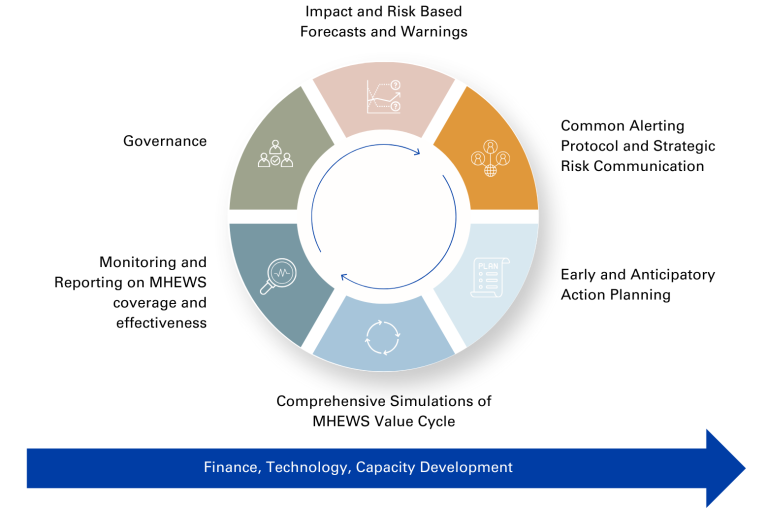Early Warnings for All Programmatic Framework for Country Level Implementation
The Early Warnings for All (EW4All) initiative aims to ensure that everyone on Earth is protected from hazardous hydrometeorological, climatological and related environmental events through life-saving early warning systems by the end of 2027. This goal is achieved through a two-phase implementation plan at the country level:
Phase 1: Catalytic action
Countries identify gaps in their current systems and mobilize key stakeholders to accelerate the implementation of multi-hazard early warning systems (MHEWS), building on existing partnerships, projects, and capacities. This process helps yield the EW4All National Road Maps tailored to guide each country’s efforts on enhancing MHEWS capacities and reach.
Phase 2: Sustained action
Common, at-scale, and collective action is undertaken to implement the EW4All National Road Maps.
Across both phases, the Interpillar Technical Coordination Group (which includes UNDRR, WMO, ITU, and IFRC) stands ready to support countries and their partners.
Interpillar Programming
The national implementation of the EW4All National Roadmap necessitates coordinated efforts across various pillars, sectors, and stakeholders to achieve comprehensive Multi-Hazard Early Warning System (MHEWS) coverage. Success hinges on strong national leadership and collaborative engagement throughout the MHEWS value cycle. In support of these objectives, the EW4All initiative has developed an interpillar programming guide to clarify and guide actions within and across MHEWS pillars. This guide aims to assist countries and their partners in maximizing impact, particularly in safeguarding vulnerable populations, in alignment with the 2027 goal.

Area 1: Impact and Risk Based Forecasts and Warnings
Countries can create weather forecasts that show not only weather events but also their potential impact on people, housing, services, and the environment. This helps in better preparing for and responding to weather events.
Area 2: Common Alerting Protocol and Strategic Risk Communication
Countries have strong communication frameworks and systems to share timely, accurate, and clear information with everyone before, during, and after hazardous events. This facilitates informed decision-making to stay safe.
Area 3: Early and Anticipatory Action Planning
Countries work with at-risk populations to develop preparedness and early action plans. These plans are included in national and local disaster risk management plans, ensuring everyone is prepared and knows what to do in emergencies.
Area 4: Comprehensive Simulations of MHEWS Value Cycle
Countries regularly practice and test their early warning systems through different scenario simulations. This helps improve their response strategies and ensures the systems work well in real-life situations.
Area 5: Monitoring and Reporting on MHEWS coverage and effectiveness
Countries monitor how well their multi-hazard early warning systems (MHEWS) are working and share their findings with national and global stakeholders. This information is used to continuously improve their approaches.
Area 6: MHEWS Governance
Countries have clear and effective management structures for their early warning systems. This includes clear policies, legal frameworks, and coordination across different sectors and levels of government, ensuring accountability and proper resource allocation.
Transversal issues for consideration:
- Financing
- Technology Development and Transfer
- Capacity Building
